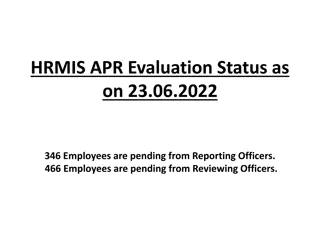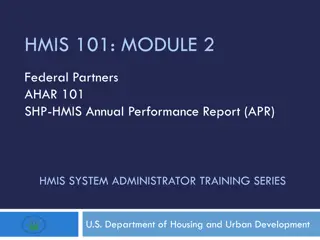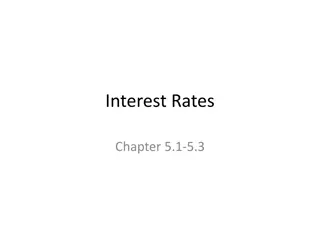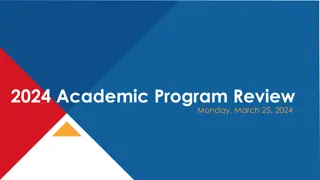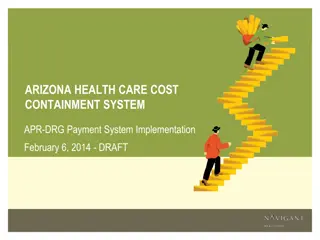
Improving Schools Through Data Analysis and State Standards
Exploring the Missouri School Improvement Program (MSIP) and the significance of using data to enhance school performance. Learn about the standards, goals, and sections of MSIP for evaluating school districts in Missouri, emphasizing the importance of data-driven decision-making for education improvement.
Download Presentation

Please find below an Image/Link to download the presentation.
The content on the website is provided AS IS for your information and personal use only. It may not be sold, licensed, or shared on other websites without obtaining consent from the author. If you encounter any issues during the download, it is possible that the publisher has removed the file from their server.
You are allowed to download the files provided on this website for personal or commercial use, subject to the condition that they are used lawfully. All files are the property of their respective owners.
The content on the website is provided AS IS for your information and personal use only. It may not be sold, licensed, or shared on other websites without obtaining consent from the author.
E N D
Presentation Transcript
USING DATA TO IMPROVE YOUR USING DATA TO IMPROVE YOUR SCHOOL SCHOOL Presenters: Area Supervisors for DESE Presenters: Area Supervisors for DESE Jill Janes; Shelly Aubuchon; Nancy Greeley Jill Janes; Shelly Aubuchon; Nancy Greeley
Our Focus For Today Why Does Data Matter? Missouri School Improvement Plan and Annual Performance Review Digging Deeper into the 5 Standards Missouri Comprehensive Data System What Is Your Data Saying About Your School And Using Data To Make Smart Decisions?
Lets begin with the WHY **All graduates college and career ready **All children kindergarten ready **Excellent educators and leaders in every classroom **Effective and efficient department
Missouri School Improvement Program MSIP began in 1990 and entered its fifth version in 2013. MSIP 6 is currently being developed. The Missouri School Improvement Program has the responsibility of reviewing and accrediting the 520 school districts in Missouri. The process of accrediting school districts is mandated by state law and by State Board of Education regulation. MSIP 5 Policy Goals 1. Articulate the state's expectations for student achievement with the ultimate goal of all students graduating ready for success in college and careers; 2. Distinguish performance of schools and districts in valid, accurate and meaningful ways so that districts in need of improvement can receive appropriate support and interventions, and high-performing districts can be recognized as models of excellence; 3. Empower all stakeholders through regular communication and transparent reporting results; and 4. Promote continuous improvement and innovation within each district.
MSIP is organized in three sections: Resource Standards, Process Standards and Performance Standards. The Resource Standards address the basic requirements that all districts should have in place. They are generally quantitative in nature and include such components as class size, course offerings, and appropriate certification. Some standards are appropriate for all districts. Other standards need to be tailored for districts in different contextual settings. The Process Standards address the instructional and administrative processes used in schools. They include standards on instructional design and practices, effective teachers and leaders, and governance. Performance Standards include multiple measures of student performance. The standards against which all school districts will be assessed include academic achievement; subgroup achievement; college and career readiness (K-12) or high school readiness (K-8); attendance; and graduation rate. The Department annually collects and analyzes data for the performance standards as part of the accreditation process.
My APR My APR What does it What does it mean? mean?
Districts earn a level of District s earn a level of accreditation based on their accreditation based on their APR points APR points. There are four levels of accreditation as follows: Accredited With Distinction Equal to or greater than 90% of the points possible on the APR and meets other criteria yet to be determined by the State Board of Education. Accredited Equal to or greater than 70% of the points possible on the APR. Provisional Equal to or greater than 50% to 69.9% of the points possible on the APR. Unaccredited Less than 50% of the points possible on the APR.
APR ---- ANNUAL PROGRESS REPORT To measure progress toward Missouri reaching Top 10 by 20 plan and to distinguish among school and district performance, the Department computes an Annual Performance Report (APR) score for each school and Local Education Agency (LEA). Five Performance Standards: 1. Academic Achievement 2. Subgroup Achievement 3. High School Readiness (K-8 district s only) or College & Career Readiness (K-12) 4. Attendance Rate 5. Graduation Rate
Lets Dig Deeper into the Standards! 1. Academic Achievement The MAP and EOC s are used to measure academic achievement. Areas that are assessed: ELA, Math, Science and S.S. Total points possible: 16 in ELA, Math and Science; 8 points in S.S. 2. Subgroup Achievement District shows improvement in the following subgroups: F/R lunch, racial/ethnic background, ELL, and students with disabilities. Areas that are assessed: ELA, Math, Science and S.S. Total points possible: 4 in ELA, Math, and Science; 2 points in S.S.
3. College and Career Readiness: The district provides adequate post-secondary preparation for all students. Indicators *1-3: Includes percent of students who scored at or above the state standard on ACT, SAT, ASVAB, WorkKeys and Compass. The district s composite score that meet or exceeds the state standard or demonstrate required improvement and the percent of graduates who participated in any of these tests. Total points possible: 10 Indicator 4: Includes percent of graduates who earned a qualifying score on AP, IB, DC or IRS, TSA. PLW courses have been added to this indicator. Total points possible: 10 Indicators *5-6: Post-secondary percent of graduates who attend post secondary education/training or are in the military within 6 months of graduation. Also the percentage of graduates who complete career education programs approved by the department and are placed in occupations directly related to their training, continue their education or are in the military within 6 months of graduating. Total points possible: 10 ***K-8 school districts can receive points here if they provide adequate post- elementary preparation for all students. Percent of students who take an EOC while in the elementary school. Total points possible: 10
4. Attendance Rate: The percent of students who regularly attend school. They follow the 90/90 rule. Total points possible: 10 5. Graduation Rate: The percent of students who complete an educational program that meets the graduation requirements. Total points possible: 30 Three years of consecutive data for each standard are used to determine status, progress and growth. Once the scores for each Standard have been generated, they are combined into a single score that is your APR score.
So Where Is This Data? MCDS Missouri Comprehensive Data System Secure information and you must be given permission to access this information.
1. Log in to Web Applications 2. Go to the MCDS Portal 3. Click on Guided Inquiry then Accountability 4. Click on MSIP 5 Annual Performance Report
Here you will find most of the reports that you will need. Summary Report Supporting Data Report MSIP 5 Annual Performance Indicator Report Standard 3 CCR Indicator 1-4 Standard 3 CCR Indicator 5-6 Standard 4 Attendance Rate Standard 5 Graduation Rate
USING AND UNDERSTANDING YOUR APR *Summary Report *Annual Performance Indicator Report *Achievement Level Report *Standard 3 CCR Indicators 1-4 *Standard 3 CCR Indicators 5-6 *Standard 3 High School Readiness K-8 *Standard 4 Attendance *Standard 5 - Graduation
WHAT WILL 2017 APR LOOK LIKE? District Report: Timeline: October 20 APR Preview October 20-27 Appeals Window October 27 (5:00 pm) Data Freeze November 8 Final APR behind secure login November 13 Embargoed APR to media November 15 Final APR release Standards 1 2 High School Readiness Building Level Report:
THE APR IS: *A Requirement *Used for classification *3 Year Picture of Your District *Contains a percentage of points earned based on performance standards *Reflects both academic and non-academic measures *Wholly based on outcomes *Used for planning instruction, spotting trends, and better preparing your students. APR Data are not intended for ranking!!!!
** We accept responsibility for our students education. ** It's not about the points. ** When we FOCUS on students, the tests take care of themselves.






